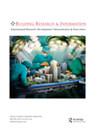Impact of setbacks on thermal comfort and visual privacy in detached houses in Jordan
IF 3.7
3区 工程技术
Q1 CONSTRUCTION & BUILDING TECHNOLOGY
引用次数: 2
Abstract
ABSTRACT Currently, there is a growing interest in enhancing building regulations in Jordan since it has a direct impact on the quality of the built environment and then on individuals’ life. Human satisfaction is connected with comfort level in several aspects, including thermal, physical, psychological, and personnel. Such a relation required a comprehensive and integrated vision to be analysed in general and in conservative culture as Jordan in specific. Therefore, this study aimed to explore the impact of buildings’ setbacks on thermal comfort and visual privacy for residential development, which has been classified into four categories based on assigned land use. Field observation and spatial analysis were done for the research setting. The relation between thermal comfort and visual privacy in a detached house was tested by using primary data that was conducted through an online survey from 254 respondents. Research data were analysed using multinomial regression analysis showing that the level of satisfaction correlates with setbacks; a higher level of satisfaction resulted from better thermal comfort and visual privacy with larger setbacks. However, this contradicts principles of sustainability that appreciate intensification guidelines to reduce sprawl. So, there is a need to revise building codes to improve the level of satisfaction and well-being.挫折对约旦独立住宅热舒适和视觉隐私的影响
摘要目前,约旦对加强建筑法规的兴趣越来越大,因为它直接影响到建筑环境的质量,进而影响到个人的生活。人的满意度在几个方面与舒适度有关,包括热、身体、心理和人员。这种关系需要一个全面和综合的愿景,以便在一般情况下以及在约旦这样的保守文化中进行分析。因此,本研究旨在探讨建筑挫折对住宅开发的热舒适性和视觉私密性的影响,根据分配的土地用途将住宅开发分为四类。对研究环境进行了实地观察和空间分析。通过对254名受访者的在线调查,使用主要数据测试了独立式住宅的热舒适性和视觉隐私之间的关系。使用多项回归分析对研究数据进行了分析,表明满意度与挫折相关;更高水平的满意度来自于更好的热舒适性和视觉私密性,同时具有更大的挫折。然而,这与可持续性原则相矛盾,可持续性原则重视强化指导方针以减少蔓延。因此,有必要修订建筑规范,以提高满意度和幸福感。
本文章由计算机程序翻译,如有差异,请以英文原文为准。
求助全文
约1分钟内获得全文
求助全文
来源期刊

Building Research and Information
工程技术-结构与建筑技术
CiteScore
8.60
自引率
7.70%
发文量
43
审稿时长
>12 weeks
期刊介绍:
BUILDING RESEARCH & INFORMATION (BRI) is a leading international refereed journal focussed on buildings and their supporting systems. Unique to BRI is a focus on a holistic, transdisciplinary approach to buildings and the complexity of issues involving the built environment with other systems over the course of their life: planning, briefing, design, construction, occupation and use, property exchange and evaluation, maintenance, alteration and end of life. Published articles provide conceptual and evidence-based approaches which reflect the complexity and linkages between cultural, environmental, economic, social, organisational, quality of life, health, well-being, design and engineering of the built environment.
 求助内容:
求助内容: 应助结果提醒方式:
应助结果提醒方式:


